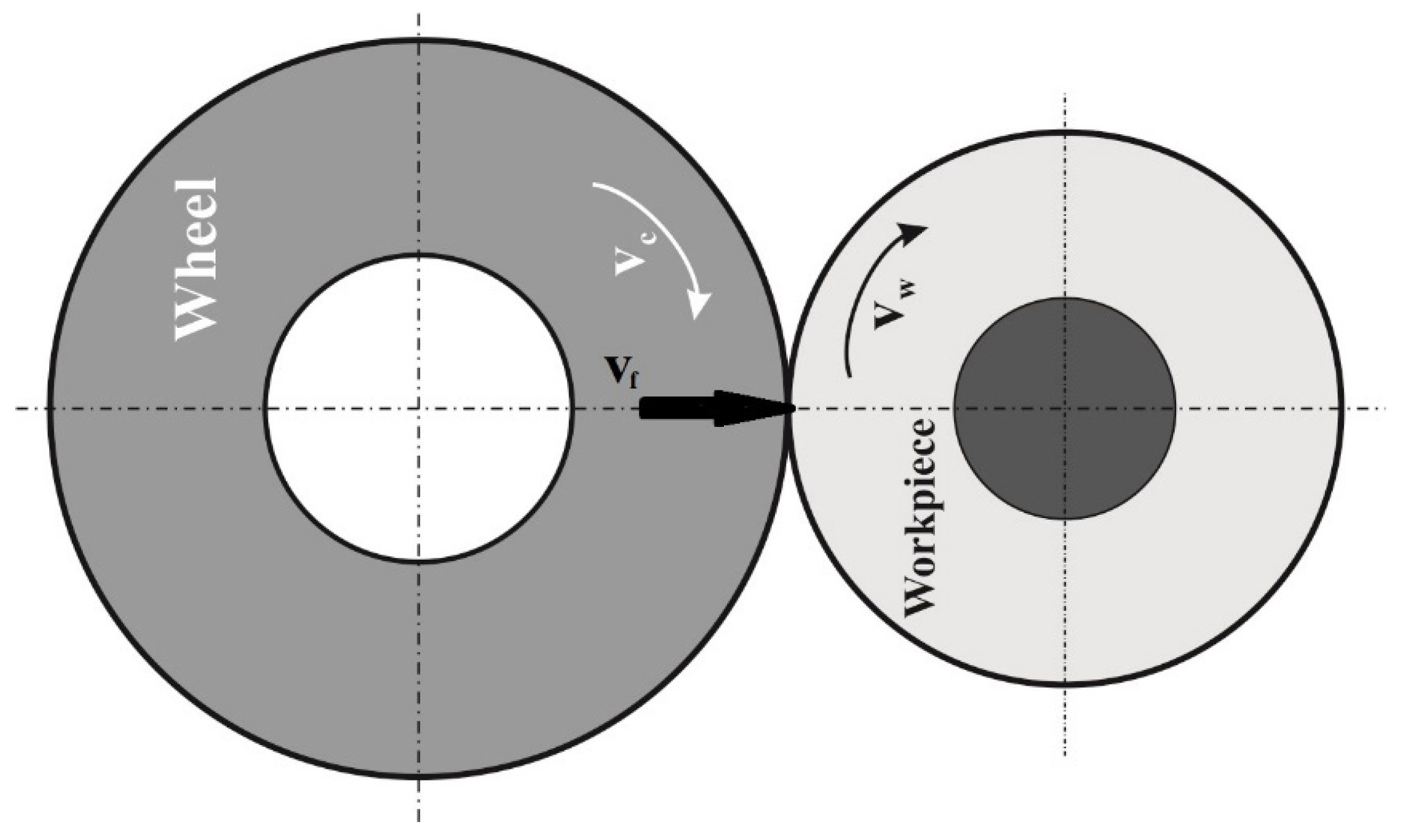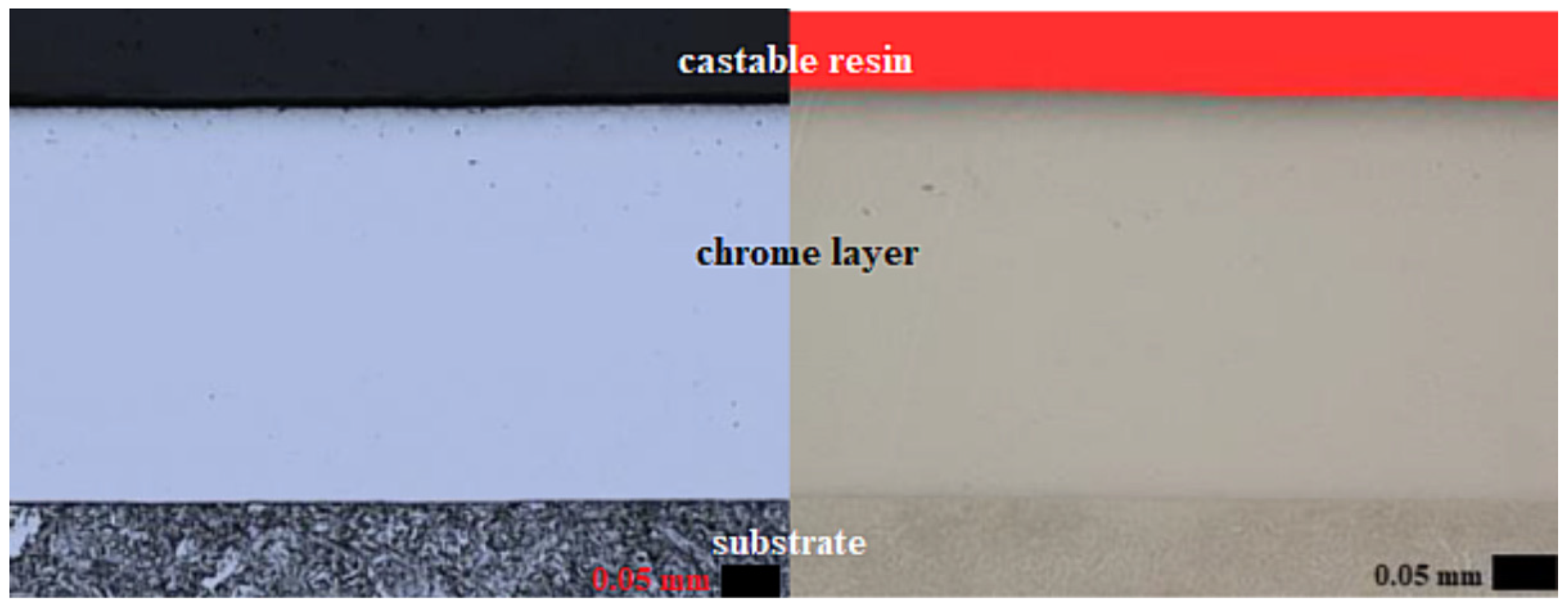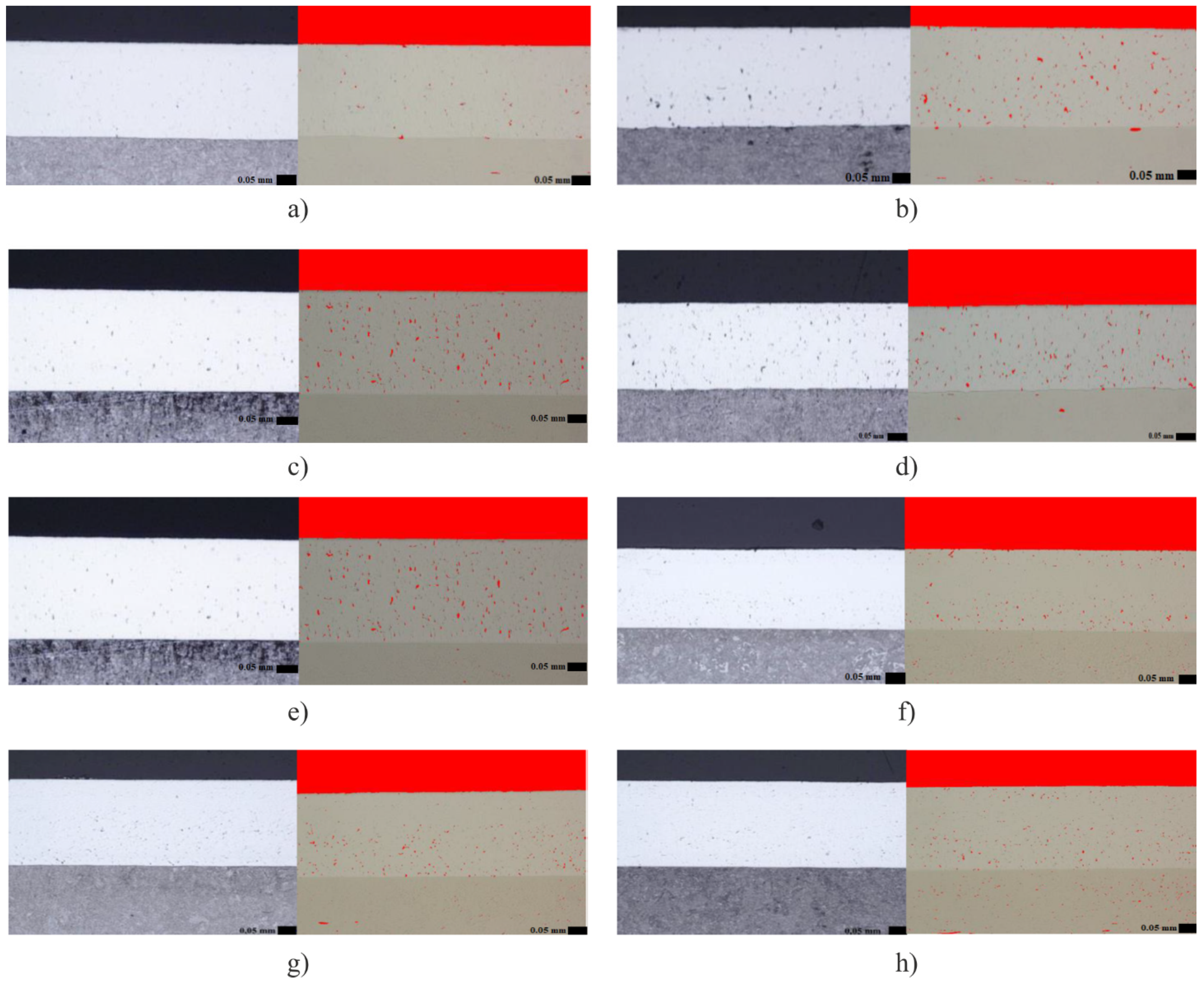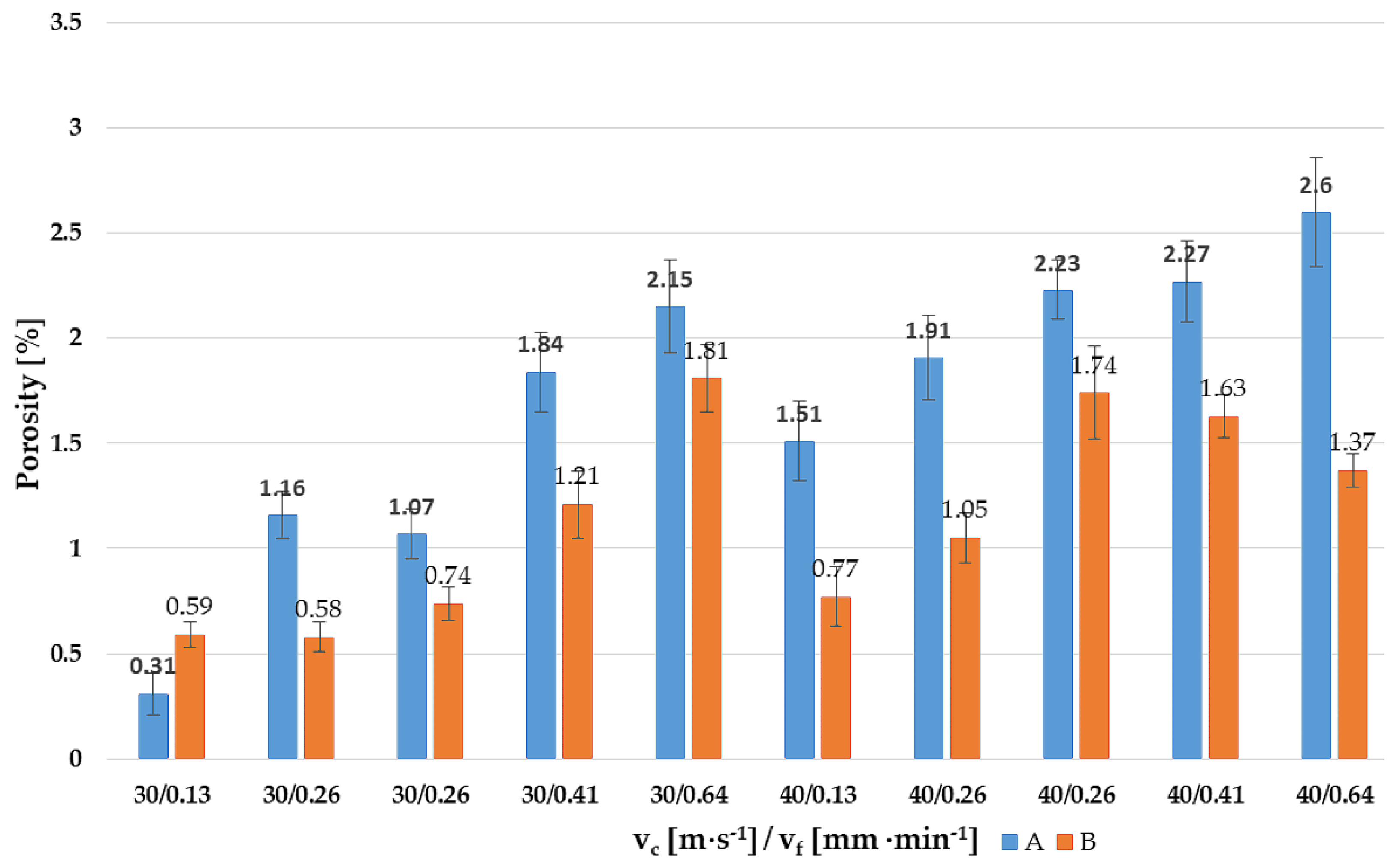Analyses of Influence on Chromium Coating after Grinding from the View of Final Microstructure and Microhardness in the Surface Layer
Abstract
1. Introduction
2. Experiment
2.1. Experimental Material
2.2. Experimental Setup
3. Results and Discussion
3.1. Evaluation of Microstructure
3.2. Evaluation of Microhardness in the Surface Layer
3.3. Discussion
4. Conclusions
- Before and after grinding, the structure of the base material was the same, i.e., it was retained. The initial microstructure of the base material was preserved and it was not changed in the transition area between the chromium layer and the base material.
- The structure of the base material was identified as sorbitol oriented along with the original martensitic needles.
- The reason is that the chromium layer could be affected and not show significant changes in the microstructure in the base material, which could potentially act as an insulator. It is likely that a transition area could be created if greater mechanical and thermal loads were applied, which evidently occurred under the given cutting conditions.
- From this point of view, suitable cutting conditions were presented.
- The evaluation of porosity in a layer of chromium may be summarized, as follows:
- A layer of chromium before the grinding process was analyzed with a porosity of 0.03%
- The porosity values after grinding ranged from 0.31% to 2.5%, which is acceptable in terms of internal conditions of the company, where the porosity is allowed up to 10%.
- The porosity value increased with the increasing feed rate. An increase in porosity also occurred when comparing the two cutting speeds of grinding wheels, where higher values were achieved for vc = 40 m·s−1. Only in the comparison of samples B5 and B10 did the value of porosity decrease. This reduction manifested itself in grinding wheel SiC.
- Lower porosity values were achieved using grinding wheel SiC.
- While using the presented cutting conditions and grinding wheels, it is important to obtain very good porosity in the chromium layer.
- Microhardness in the chromium layer for both grinding wheels and under certain cutting conditions had a slightly different course of microhardness.
- The initial value of microhardness before the grinding process in the chromium layer was around 950 HV0.1.
- After grinding, the microhardness values of the chromium layer ranged between 960 to 975 HV0.1.
- The initial value of microhardness before the grinding process in the base material (substrate) was around 350 HV0.1.
- After grinding, the microhardness values in the base material just below the transition area increase to 365 to 385 HV0.1 and to a distance of 0.05 mm in the surface layer of the base material. At a depth of 0.05 to 0.2 mm of the base material, the microhardness values gradually decrease back to the core hardness value. Subsequently, at a depth of 0.2 to 0.4 mm, the microhardness values were around 350 HV0.1. Reinforcement in the surface layer of the base material occurred due to thermal and mechanical loading.
- These microhardness courses were similar for both of the grinding wheels.
Author Contributions
Funding
Institutional Review Board Statement
Informed Consent Statement
Data Availability Statement
Conflicts of Interest
Nomenclature
| Symbols and acronyms | |
| AISI | American Iron and Steel Institute |
| CBN | Cubic Boron Nitrid |
| CCA | compressed cooled air |
| MQL | minimum quantity lubrication |
| SAE | Society of Automotive Engineers |
| SG | solgel, ceramic abrasives prepared by sol-gel method (microcrystalline corundum) |
| ae | removal depth [mm] |
| vc | cutting speed [m·s−1] |
| vf | radial feed of tool [mm·min−1] |
| vw | circumferential speed of the workpiece [m·min−1] |
References
- Malkin, S.; Guo, C. Grinding Technology: Theory and Application of Machining with Abrasives, 2nd ed.; Industrial Press Inc.: London, UK; New York, NY, USA, 2008. [Google Scholar]
- Brychta, J.; Čep, R.; Sadílek, M.; Petřkovská, L.; Nováková, J. Nové Směry v Progresivním Obrábění, 1st ed.; Technical University of Ostrava: Ostrava, Czech Republic, 2007. [Google Scholar]
- Rowe, W. Principles of Modern Grinding Technology, 2nd ed.; William Andrew Publishing: New York, NY, USA, 2013. [Google Scholar]
- Marinescu, I.D.; Hitchiner, M.; Uhlmann, E.; Rowe, B.W.; Inasaki, I. Handbook of Machining with Grinding Wheels, 1st ed.; CRC Press: Boca Raton, FL, USA, 2006. [Google Scholar]
- Marinescu, I.D.; Rowe, W.B.; Dimitrov, B.; Inasaki, I. Tribology of Abrasive Machining Processes, 1st ed.; William Andrew Publishing: New York, NY, USA, 2004. [Google Scholar]
- Childs, T.; Maekawa, K.; Obikawa, T.; Yamane, Y. Metal Machining: Theory and Applications, 1st ed.; Butterworth-Heinemann: London, UK, 2000. [Google Scholar]
- Tracton, A.A. Coatings Technology Handbook, 3rd ed.; CRC Press: Boca Raton, FL, USA, 2005. [Google Scholar]
- Lou, H.H.; Huang, Y. Electroplating. In Encyclopedia of Chemical Processing; Taylor & Francis: Abingdon, UK, 2006; pp. 839–848. [Google Scholar]
- Kraus, V. Povrchy a Jejich úpravy, 1st ed.; WBU: Plzeň, Czech Republic, 2000. [Google Scholar]
- Lunk, H.J. Discovery, properties and applications of chromium and its compounds. ChemTexts 2015, 1, 1–17. [Google Scholar] [CrossRef]
- Cotell, C.M.; Sprague, J.A.; Smidt, F.A. Surface Engineering. In ASM Handbook, 1st ed.; ASM International: Materials Park, OH, USA, 1994; Volume 5. [Google Scholar]
- Bumbálek, L.; Bumbálek, B.; Mazal, P.; Liškutín, P. Vlastnosti Povrchové Vrstvy a Jejich vliv na únavu, 1st ed.; CERM: Brno, Czech Republic, 2004. [Google Scholar]
- Nguyen, V.P.; Dang, T.N.; Le, C.C.; Wang, D.A. Effect of Coating Thickness on Fatigue Behavior of AISI 1045 Steel with HVOF Thermal Spray and Hard Chrome Electroplating. J. Therm. Spray Technol. 2020, 29, 1968–1981. [Google Scholar] [CrossRef]
- Beneš, P.; Kříž, A.; Hájek, J. Odolnost Chromových Vrstev Vůči Opotřebení. Vrstvy a Povlaky 2006; Digital Graphic: Trenčín, Czech Republic, 2006; pp. 177–182. [Google Scholar]
- Dennis, J.K.; Such, T.E. Nickel and Chromium Plating, 3rd ed.; Woodhead Publishing: Cambridge, UK, 1993. [Google Scholar]
- Pelar, C.; Greenaway, K.; Zea, H.; Wu, C.H.; Luhrs, C.C.; Phillips, J. Novel Chemical Process for Producing Chrome Coated Metal. Materials 2018, 11, 78. [Google Scholar] [CrossRef] [PubMed]
- Maruda, R.W.; Krolczyk, G.M.; Michalski, M.; Nieslony, P.; Wojciechowski, S. Structural and microhardness changes after turning of the AISI 1045 steel for minimum quantity cooling lubrication. J. Mater. Eng. Perform. 2016, 26, 431–438. [Google Scholar] [CrossRef]
- Nadolny, K.; Kieraś, S. Experimental Studies on the Centrifugal MQL-CCA Method of Applying Coolant during the Internal Cylindrical Grinding Process. Materials 2020, 13, 2383. [Google Scholar] [CrossRef] [PubMed]
- Khan, A.M.; Jamil, M.; Mia, M.; Pimenov, D.Y.; Gasiyarov, V.R.; Gupta, M.K.; He, N. Multi-Objective Optimization for Grinding of AISI D2 Steel with Al2O3 Wheel under MQL. Materials 2018, 11, 2269. [Google Scholar] [CrossRef] [PubMed]
- Ding, W.F.; Linke, B.; Zhu, Y.J.; Li, Z.; Fu, Y.C.; Su, H.H. Review on monolayer CBN superabrasive wheels for grinding metallic materials. Chin. J. Aeronaut. 2016, 30, 109–134. [Google Scholar] [CrossRef]
- Wang, H.; Li, X.; Wang, Z.; Xu, R. Influence of Electroplated CBN Wheel Wear on Grinding Surface Morphology of Powder Metallurgy Superalloy FGH96. Materials 2020, 13, 1005. [Google Scholar] [CrossRef] [PubMed]
- Bruschi, S.; Pezzato, L.; Ghiotti, A.; Dabalà, M.; Bertolini, R. Effectiveness of using low-temperature coolants in machining to enhance durability of AISI 316L stainless steel for reusable biomedical devices. J. Manuf. Process. 2019, 39, 295–304. [Google Scholar] [CrossRef]
- Lattner, R.; Holešovskỳ, F.; Novák, M.; Vrabel, M. Grinding of Titanium Alloy Ti6Al4V with Silicon Carbide Grinding Wheel. Manuf. Technol. 2016, 16, 159–162. [Google Scholar]
- Taylor, E.; Slatter, T. Role of Temperature Parameters in Achieving Precision Traverse Cylindrical Grinding of Chrome-Plated Ferrous Metal Rolls. J. Manuf. Sci. Eng. 2017, 139, 1–45. [Google Scholar] [CrossRef]
- Jawahir, I.S.; Brinksmeier, E.; M’Saoubi, R.; Aspinwall, D.K.; Outerio, J.C.; Meyer, D.; Umbrello, D.; Jayal, A.D. Surface integrity in material removal processes. CIRP Ann. Manuf. Technol. 2011, 60, 603–626. [Google Scholar] [CrossRef]
- Novák, M. Vybrané parametry integrity povrchu při broušení kalených ocelí. In Technologie Strojírenské Výroby: Základ Kvality Výrobku; JEPU: Ústí nad Labem, Czech Republic, 2012; pp. 55–70. [Google Scholar]
- Marek, M.; Novák, M.; Šramhauser, K. The Impact of Changes in Feed Rate on Surface Integrity after Chrome Plate Grinding by Microcrystalline Corundum. Manuf. Technol. 2019, 19, 461–468. [Google Scholar]
- Marek, M.; Novák, M. The Effect of Changes in Feed Rate on Surface Integrity during Nickel Coating Grinding. Solid State Phenom. 2017, 261, 207–214. [Google Scholar] [CrossRef]
- Novák, M.; Náprstková, N.; Ohmori, H. Grinding of the Alloy INCONEL 718 and Final Roughness of the Surface. Key Eng. Mater. 2016, 686, 212–217. [Google Scholar] [CrossRef]
- Novak, M.; Naprstkova, N. Grinding of the Alloy INCONEL 718 and Final Roughness of the Surface and Material Share. Manuf. Technol. 2015, 15, 1015–1023. [Google Scholar] [CrossRef]
- Medlin, D.; Kuhn, H. Mechanical Testing and Evaluation. In ASM Handbook, 1st ed.; ASM International: Materials Park, OH, USA, 2000; Volume 8. [Google Scholar]
- Stančeková, D.; Sapieta, M.; Rudawska, A.; Náprstková, N.; Janota, M. Production Process Intensification of a Specific Friction Bearing by Change of Production Technology and Used Material. In Proceedings of the METAL 2019—28th International Conference on Metallurgy and Materials, Brno, Czech Republic, 22–24 May 2019; pp. 826–831. [Google Scholar]
- Stančeková, D.; Šajgalík, M.; Mrázik, J.; Rudawska, A.; Janota, M. Analysis of Integrity of Surface of Hardened Chromium-Nickel Steel after Finishing Grinding. Manuf. Technol. 2018, 18, 833–838. [Google Scholar]
- OTAI Special Steels. Available online: www.astmsteel.com/product/4340-steel-aisi/ (accessed on 11 December 2020).
- AEON Materials Corp. Available online: http://www.aeonmaterials.com/Pages/AlloySteels.aspx (accessed on 11 December 2020).







| Chemical Composition [wt.%] | ||||||||
|---|---|---|---|---|---|---|---|---|
| C | Mn | P | Cr | Mo | S | Ni | Si | Fe |
| 0.37–0.43 | 0.6–0.8 | max. 0.035 | 0.7–0.9 | 0.2–0.3 | max. 0.04 | 1.65–2.00 | 0.15–0.35 | 96 |
| Value | Min. | Max. |
|---|---|---|
| Tensile Strength in Tension Rm [MPa] | 850 | 1555 |
| Yield Strength in Tension Re [MPa] | 635 | 1125 |
| Ductility [%] | 5 | 13 |
| Hardness [HRC] | 24 | 45 |
| Chemical Composition [wt.%] | ||||||||
|---|---|---|---|---|---|---|---|---|
| C | Mn | P | Cr | Mo | S | Ni | Si | Fe |
| 0.415 | 0.711 | <0.005 | 0.817 | 0.243 | <0.001 | 1.835 | 0.263 | 95.300 |
| Material | Grinding Wheel | Cutting Conditions | Sample No. | |||
|---|---|---|---|---|---|---|
| ae [mm] | vw [m·min−1] | vc [m·s−1] | vf [mm·min−1] | |||
| Galvanically applied chromium layer | SG | 0.05 | 15 | 30 | 0.13 | A1 |
| 0.17 | A2 | |||||
| 0.26 | A3 | |||||
| 0.41 | A4 | |||||
| 0.64 | A5 | |||||
| 40 | 0.13 | A6 | ||||
| 0.17 | A7 | |||||
| 0.26 | A8 | |||||
| 0.41 | A9 | |||||
| 0.64 | A10 | |||||
| SiC | 30 | 0.13 | B1 | |||
| 0.17 | B2 | |||||
| 0.26 | B3 | |||||
| 0.41 | B4 | |||||
| 0.64 | B5 | |||||
| 40 | 0.13 | B6 | ||||
| 0.17 | B7 | |||||
| 0.26 | B8 | |||||
| 0.41 | B9 | |||||
| 0.64 | B10 | |||||
Publisher’s Note: MDPI stays neutral with regard to jurisdictional claims in published maps and institutional affiliations. |
© 2021 by the authors. Licensee MDPI, Basel, Switzerland. This article is an open access article distributed under the terms and conditions of the Creative Commons Attribution (CC BY) license (https://creativecommons.org/licenses/by/4.0/).
Share and Cite
Náprstková, N.; Novák, M.; Marek, M.; Šramhauser, K.; Sviantek, J.; Stančeková, D.; Ťavodová, M. Analyses of Influence on Chromium Coating after Grinding from the View of Final Microstructure and Microhardness in the Surface Layer. Materials 2021, 14, 2396. https://doi.org/10.3390/ma14092396
Náprstková N, Novák M, Marek M, Šramhauser K, Sviantek J, Stančeková D, Ťavodová M. Analyses of Influence on Chromium Coating after Grinding from the View of Final Microstructure and Microhardness in the Surface Layer. Materials. 2021; 14(9):2396. https://doi.org/10.3390/ma14092396
Chicago/Turabian StyleNáprstková, Nataša, Martin Novák, Martin Marek, Karel Šramhauser, Jan Sviantek, Dana Stančeková, and Miroslava Ťavodová. 2021. "Analyses of Influence on Chromium Coating after Grinding from the View of Final Microstructure and Microhardness in the Surface Layer" Materials 14, no. 9: 2396. https://doi.org/10.3390/ma14092396
APA StyleNáprstková, N., Novák, M., Marek, M., Šramhauser, K., Sviantek, J., Stančeková, D., & Ťavodová, M. (2021). Analyses of Influence on Chromium Coating after Grinding from the View of Final Microstructure and Microhardness in the Surface Layer. Materials, 14(9), 2396. https://doi.org/10.3390/ma14092396







